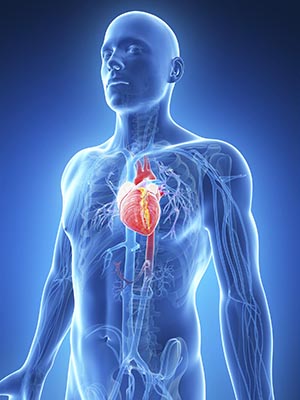 After a heart attack, the injured heart often enlarges and pumps with less efficiency in a process called remodeling as part of heart failure. While many factors contribute to remodeling, the current study focused on the role of inflammation, the body’s response to injury or infection, where immune cells destroy invading microbes and remove damaged tissue.
After a heart attack, the injured heart often enlarges and pumps with less efficiency in a process called remodeling as part of heart failure. While many factors contribute to remodeling, the current study focused on the role of inflammation, the body’s response to injury or infection, where immune cells destroy invading microbes and remove damaged tissue.In autoimmune diseases, the same immune responses mistakenly target and injure healthy tissue and, given enough time, change their size and function. Inflammation is a known feature of heart failure, and it is associated with high levels of inflammatory proteins called cytokines — including one called tumor necrosis factor alpha or TNF-a — that ramp up immune cell responses.
In recent years, researchers have successfully countered autoimmune diseases like rheumatoid arthritis by suppressing the immune response with antibodies engineered to stop the action of TNF-a. However, attempts to counter inflammation’s contribution to heart failure using anti-TNF-a antibody treatments like Enbrel and Remicade failed in clinical trials.
“Our results suggest that heart failure would be better addressed by treatments that shut down immune cells that are both sources and targets of cytokines in the spleen and heart, instead of targeting any one cytokine,” said Sumanth Prabhu, M.D., director of the Division of Cardiovascular Disease within the UAB School of Medicine and study leader. “In other words, we need treatments that address a very complex signaling system instead of one signal.”
The team found that inflammatory damage in the heart cannot occur without the help of macrophages and dendritic cells made by the spleen, and that heart failure is to some degree an autoimmune disease.
“The fact that the field has successfully bioengineered antibodies to oversee the removal of TNF-a suggests that we can design other antibodies to remove spleen-derived immune cell subsets, or the proteins issuing from failing hearts that turn them on,” Prabhu added. “We have the tools if we can just identify the specific drivers of sustained inflammation in heart failure.”
Crosstalk and memory
The current study found that mice meant to serve as a model of ischemic human heart failure (weaker blood flow after a heart attack) had higher levels of activated, pro-inflammatory macrophages, monocytes, dendritic cells and T cells trafficking between their hearts and spleens than did control mice with healthy hearts.
Prabhu and colleagues propose that early damage in failing hearts causes the release of proteins, possibly belonging to a class called alarmins, which are engulfed by and activate a larger than normal number of macrophages and dendritic cells that reside in the heart. These cells travel to the spleen, where they present alarmins (or other antigens) to T cells. Several immune cell types then return to the heart to cause further inflammation, damage and remodeling.
Further, the study suggests that immune cells programmed to deliver a pro-inflammatory message to the heart remember it. When transplanted into healthy mice, immune cells activated in heart failure soon brought about inflammation that drove heart failure. Removal of the spleen protected mice from the effects of inflammation in heart failure.
Heart failure can develop on its own or in the wake of damage caused by a heart attack, with the current study looking at the latter, Prabhu says. The authors suspect that the two heart failure types are driven by common mechanisms, but with different triggers and timing.
The next steps for Prabhu’s team will be to determine whether or not cardiac alarmins or other proteins are the trigger for inflammation in heart failure and to design antibodies that label them for removal.
This work was supported by a VA Merit Award, grants from the National Institutes of Health (HL-78825 and HL- 99014) and the American Heart Association (SDG award 0835456N).
Along with Prabhu, authors in the UAB Division of Cardiovascular Disease included Mohamed Ameen Ismahil, Ph.D.; Tariq Hamid, Ph.D.; Shyam Bansal, Ph.D.; and Bindiya Patel, B.S.; as well as Justin Kingery, M.D., Ph.D., in the Department of Medicine at the University of Louisville.